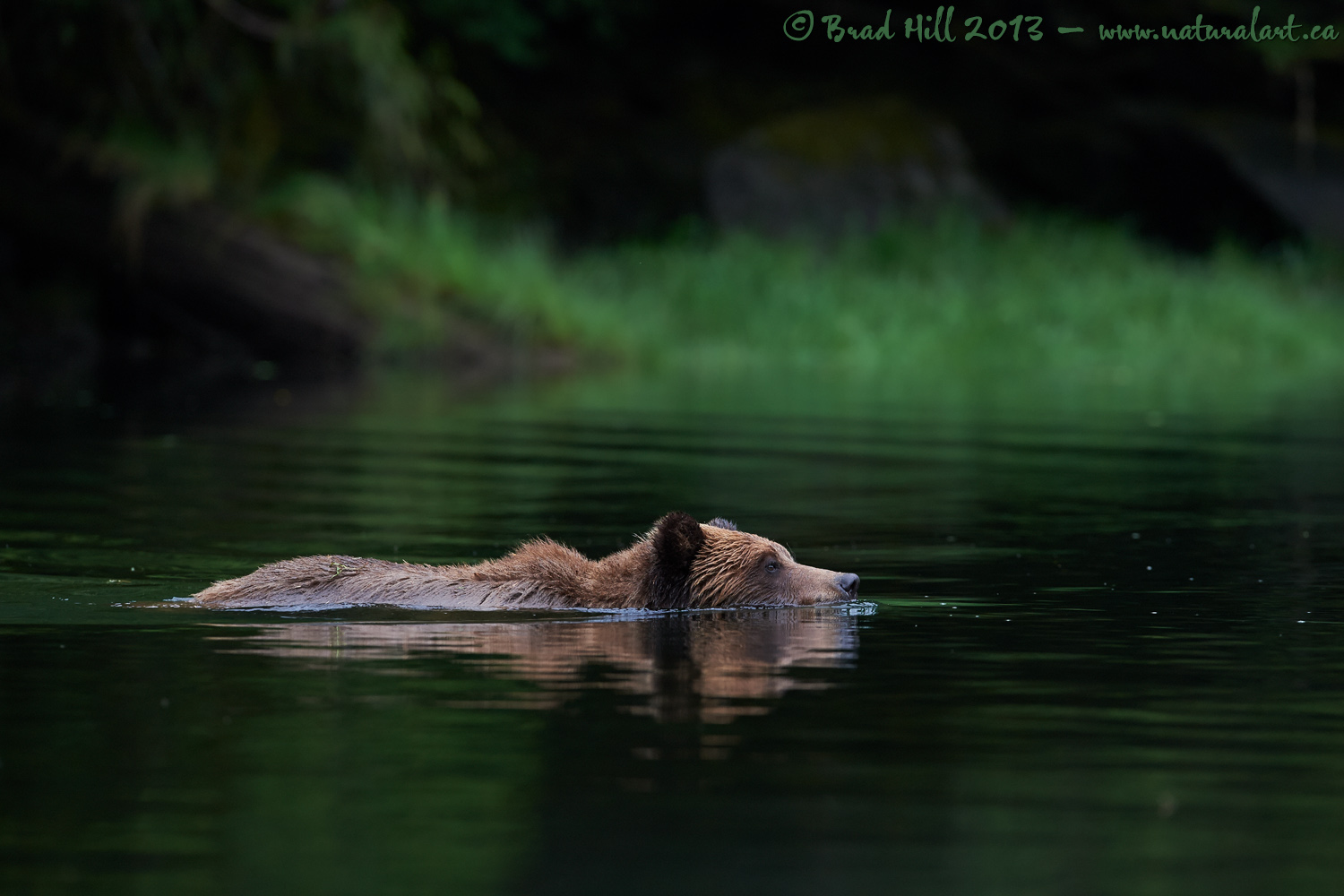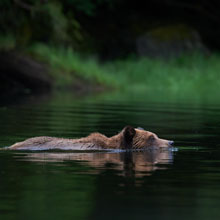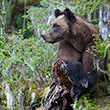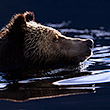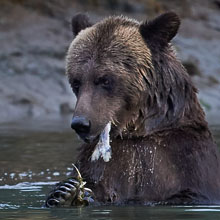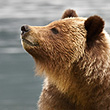Availability: Undetermined - Enquiries?
In the Field
Khutzeymateen Light. Khutzeymateen Grizzly Sanctuary, Great Bear Rainforest (northern BC coast). May 30, 2013.
The upper reaches of the Khutzeymateen Inlet ends in a wide estuary that is filled with many channels and that is subject to large tides - there's often a differential of 20' or more between high and low tide. At high tide the outer edges of the estuary almost meets the forest, with only a thin bright fringe of verdant grass rimming the edge of the channels. Add in low winds and calm water, steep surrounding mountains, misty skies, and you're left with a place where the lighting can be just amazing. The tall forest surrounding the estuary can lead to very dark shadows and inky-black water, and the often diffuse light provided by the mist can lead to what is almost a contradiction in lighting effects - very high contrast scenes but with softly illuminated subjects!
This scene is one of the best examples I can think of illustrating the "contrasty soft scenes" that you can find in the Khutzeymateen. The female grizzly shown is cruising along the edge of the forest and everything behind her is in deep shade that has produced exceptionally dark and rich reflective coloration in the water she that is swimming in. Yet the bear itself is outside of the shaded region and is being naturally illuminated by diffuse light to the point where she is almost glowing! This amazing lighting - and, of course, the presence of large numbers of grizzly bears - is what draws me back to the Khutzeymateen year after year.
One brief technical comment about this image. Scenes like this - where the majority of the image is very dark - can be tough to expose correctly. Many of today's photographers rely on the multi-segment light metering system of their camera ("evaluative" metering on the Canon side, "matrix" metering for those using Nikons). These systems work well, but they assume that the scene being viewed is neutral gray overall and they will give you "suggested" aperture and shutter speed combinations that produce a neutral gray outcome. This scene is WAY off neutral gray, and if you accepted the metering suggestion of your camera the scene you captured would be WAY too light overall and the bear would be completely over-exposed (blown out). It may seem counter-intuitive to some, but when you encounter a dark scene like this (and particularly when your subject is lighter than the rest of the scene), you have to compensate by under-exposing the image significantly (compared to the camera's suggested exposure). In this case I under-exposed the image by one full stop and JUST saved the highlight details on the bear (and exposed the dark, dark water and background correctly).
Here's a larger (2400 pixel) version of this beautiful bruin
• Khutzeymateen Light: Download 2400 pixel image (JPEG: 1.1 MB)
ADDITIONAL NOTES:
1. This image - in all resolutions - is protected by copyright. I'm fine with personal uses of them (including use as desktop backgrounds or screensavers on your own computer), but unauthorized commercial use of the image is prohibited by law. Thanks in advance for respecting my copyright!
2. This image was captured during one of my two spring "Grizzlies of the Khutzeymateen" photo tours in May/June of 2013. Each year I offer trips into two different parts of the Great Bear Rainforest as well as one to photograph aquatic mammals and oceanscapes near the northern tip of Vancouver Island. And, in selected years, I also offer photo tours to locations to capture other highly sought-after subjects, such as various boreal owl species and wildlife of Canada's Arctic. Details about these trips can be found on the Photo Tours page of this website.
3. Like all wildlife photographs on this website, this image was captured following the strict ethical guidelines described in The Wildlife FIRST! Principles of Photographer Conduct. I encourage all wildlife photographers to always put the welfare of their subjects above the value of their photographs.
Behind the Camera
Khutzeymateen Light. Khutzeymateen Grizzly Sanctuary, Great Bear Rainforest (northern BC coast). May 30, 2013.
Digital Capture; Compressed RAW (NEF) 14-bit format; ISO 2800.
Nikon D4 paired with Nikkor 400mm f2.8 VR - hand-held from floating Zodiac. VR on and in normal mode.
1/500s @ f5; -1.0 stop compensation from matrix-metered exposure setting.
At the Computer
Khutzeymateen Light. Khutzeymateen Grizzly Sanctuary, Great Bear Rainforest (northern BC coast). May 30, 2013.
RAW Conversion to 16-bit TIFF, including first-pass/capture sharpening using Capture One Pro version 7. Two raw variants (images processed from raw) differing by a total of 0.5 stops in total exposure.
Further digital corrections on resulting 16-bit TIFF files using Adobe's Photoshop CC. Photoshop adjustments included compositing/blending of the two exposure variants, very minor colour tweaks (hue rotation and desaturation of selected colours), further selective exposure tweaks and selective contrast adjustment, and selective sharpening for web output.
Conservation
Khutzeymateen Light. Khutzeymateen Grizzly Sanctuary, Great Bear Rainforest (northern BC coast). May 30, 2013.
Ten percent of the revenue generated by this image will be donated to Raincoast*.
Species Status in Canada**: Special Concern (May 2002).
While Grizzly Bears (Ursus arctos) are not technically listed as "Endangered" in Canada, they have been extirpated from most of their historical range. Grizzly Bears are far more sensitive to intrusion/disturbance in their habitat than are Black Bears and are being increasingly forced into marginal habitat by human encroachment. The Great Bear Rainforest along the central and northern coast of British Columbia is one of the last strongholds of the Grizzly Bear in Canada, and even this population is coming under increasing pressure.
On December 18, 2017 the government of British Columbia banned grizzly hunting across the entire province. This major conservation victory came after decades of tireless work by many dedicated conservationists and ecologists and, most importantly, it reflects the opinion of the vast majority of British Columbians. And, it means that AT LEAST while the current government remains in power grizzlies are finally "safe" in British Columbia.
Now that we've at least temporarily won the battle to save grizzlies in BC, it's time to re-focus our efforts toward protecting ALL of BC's carnivores, including Gray Wolves, Black Bears, Cougars, Wolverines, and more! Simply put, there are no ecological, economic, or ethical arguments supporting the trophy hunting of carnivores.
In a great first step towards ending the hunting of carnivores throughout BC the Raincoast Conservation Foundation has developed a program designed to protect ALL carnivores within the Great Bear Rainforest. Details about this program can be found on this page on Raincoast's website. Check it out and, better yet, make a donation to help Raincoast purchase the remaining commercial hunting tenures in the Great Bear!
*The Raincoast Conservation Society (and Foundation) is an effective and efficient organization that has been fighting for protection of this unique habitat. If you are looking for a meaningful way to contribute to the conservation of this amazing ecosystem, Raincoast will provide maximal "bang" for your conservation dollars.
**as determined by COSEWIC: The Committee on the Status of Endangered Wildlife in Canada












